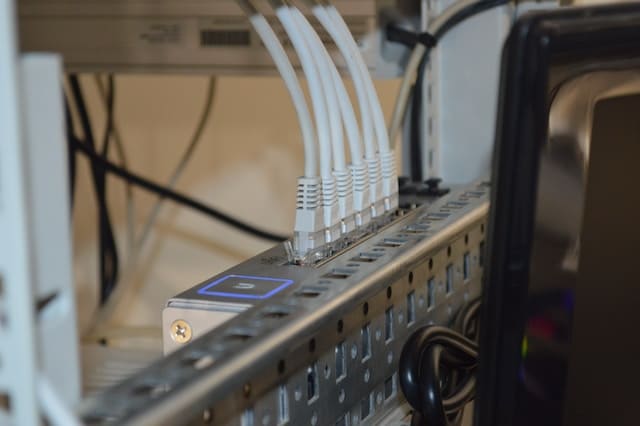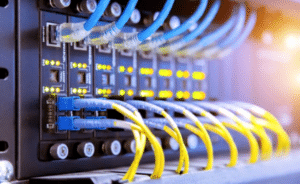In the digital world of today, having a stable internet connection at home is just as important as having running water. The internet is now part of almost every part of a person’s life, from work and school to fun and getting to know other people. Our always-connected lives require a reliable internet link, whether we’re watching HD videos online, having virtual meetings, or calling loved ones on the other side of the world. If you want to make the most of today’s huge digital world, you need to find a stable link. Because of this, it’s important to use up-to-date tools like Limitless Referrals to find the best deals and fastest service providers. https://limitlessreferrals.info/
There is an increase in the need for high-capacity networks due to the rising use of smartphones, IoT devices, and cloud-based services.
To keep up with the rapid pace of the digital world, more and more households rely on high-speed internet connections.
I. Explain How Ethernet Technology Plays A Crucial Role In Home Networking
When it comes to the tools available to build a stable private network, Ethernet shines. Ethernet, sometimes known as wired networking, is a standard for connecting computers and other electronic devices over a local area network (LAN) or the Internet. When opposed to wireless connections, which are susceptible to interference and signal loss, Ethernet provides a more secure, resilient, and low-latency connection.
New developments in Ethernet technology, such as Gigabit Ethernet and Ethernet over Powerline (EoP), have increased data transfer rates and network range. Many homes are making the conversion to Ethernet networks because of their speed and reliability in meeting the demands of modern internet users.
II. Benefits of Using Ethernet in Home Networking
A. Faster and More Stable Internet Speeds
Ethernet technology is great for home networking since it provides speedier connectivity. Ethernet is always on and has plenty of capacity, but wireless connections are susceptible to interference from other devices and networks. This implies that data transfers are quicker, which is perfect for always-online professions.
Ethernet’s consistent connection ensures that users may reliably download large files, watch media streams, and join video conferences. Ethernet’s large bandwidth means that multiple users and devices can be online at once without anyone’s experience suffering.
B. Reduced Latency and Improved Online Gaming Experience
Low latency is essential for a seamless gaming experience free of pauses and interruptions. The latency of an Ethernet connection is far lower than that of a wireless one. Even a few milliseconds of lag can have a significant effect on gameplay in multiplayer online games.
By using an Ethernet cable to link your gaming console or computer directly to the router, you may greatly improve response times. This benefit is especially meaningful in competitive gaming, where split-second decisions can be the difference between victory and defeat. With Ethernet, gamers can focus solely on the action on the screen, without any interruption from lag or delay.
C. Seamless 4K Streaming and HD Video Conferencing Capabilities
With an ever-increasing need for high-quality video content and online meetings, Ethernet’s dependability is more important than ever. A reliable and speedy internet connection is necessary for watching 4K videos online or participating in HD video conferences without interruptions or pixelation.
Since Ethernet is able to maintain constant transmission speeds, consumers may watch their streams in crisp HD quality without any hiccups. Ethernet ensures seamless communication and boosts the overall efficiency of virtual meetings for organizations and remote workers holding video conferencing.
D. Enhanced Security and Privacy Compared to Wireless Connections
Security is the top priority in any private network. While there are many benefits to using a wireless network, there is also a higher risk of cyber assaults, data breaches, and network interference. Ethernet’s wired nature makes it safer and more private than wireless alternatives.
Ethernet, in contrast to wireless connections, may only be accessible inside the premises via a cable, thus lowering the likelihood of unauthorised access. Ethernet is commonly preferred by enterprises and individuals who place a premium on privacy and security because of this added layer of protection.
Virtual local area networks (VLANs) and Media Access Control (MAC) address filtering are two additional layers of defence that can be added to Ethernet networks.
III. The Future Of Ethernet And Home Networking
Ethernet, a foundational technology for home networking, develops alongside other protocols. Ethernet has a bright future since it can readily adapt to new technologies while also increasing in speed and usefulness. In this essay, we’ll trace Ethernet’s history and examine the enormous effect it has had on internal networks.
A. Analyzing the Developments of Ethernet (2.5G, 5G, and 10G Ethernet, etc.)
With advances in Ethernet like 2.5G, 5G, and 10G Ethernet, data transfer rates are being pushed to their limits. Businesses and consumers are warming up to these versions because they are much better than standard Gigabit Ethernet in important ways.
The rate of data flow is twice as fast with 2.5G Ethernet as it is with Gigabit Ethernet. When data transfer rates of more than 1 Gbps are needed, like when streaming HD video or sending big files, this upgrade makes both speed and reliability much better.
5G Ethernet is not the same as 5G mobile networks. It has transfer rates of up to 5 Gbps. This impressive change was caused by the rise in fame of bandwidth-intensive uses like augmented reality, virtual reality, and 4K video streaming.
10G Ethernet is the fastest Ethernet standard right now, with transfer speeds of up to 10 gigabits per second. High-bandwidth apps and content creation are becoming more popular, which has made 10G Ethernet, which was once only used in businesses, more cheap for home networking fans.
As these faster Ethernet types become more common and affordable, homeowners will be able to take full advantage of the digital change.
B. The Role of Ethernet in Supporting Emerging Smart Home Devices and IoT
With the proliferation of smart home devices, the IoT revolution is changing the way we interact with our personal spaces. The increasing popularity of Internet of Things (IoT) gadgets in the home necessitates a solid and dependable network setup to support everything from smart thermostats and lights to voice-activated assistants and security cameras.
Supporting and linking these new smart home gadgets will be a major responsibility for Ethernet technology. Ethernet has advantages over Wi-Fi in terms of reliability and bandwidth, both of which are essential for the kind of always-on, always-connected operation that is required of smart devices. Because of Ethernet’s high stability and low latency, smart home devices can instantly respond to user commands, leading to a better overall experience.
IV.Conclusion
Ethernet technology is a major step forward for home networking, with many advantages that greatly improve web surfing. Ethernet is the best option for today’s digital lifestyles since it provides quicker and more stable internet connection rates, ensuring uninterrupted streaming, gaming, and video conferencing. Its low latency and compatibility with new IoT and smart home technologies help to create a smarter, more connected home. Check out this helpful instruction if you want to run an Ethernet connection throughout your home.
Frequently Asked Questions (FAQ)
- When compared to Wi-Fi, how would you describe Ethernet?
Using Ethernet wires, computers and other devices can connect to one another and the web. In comparison to Wi-Fi, another wireless networking technology, its connections are faster and more reliable.
- Just how would switching to Ethernet better my home connection?
Ethernet’s benefits to the internet are numerous, and include quicker data transfers, lower latency, and more reliable connections. The speed is fantastic for downloading large files and playing games in 4K.
- Is Ethernet compatible with my current network configuration?
Ethernet may typically make advantage of the existing internet infrastructure. If a router includes Ethernet ports, you can use an Ethernet cable to connect your devices directly to it. If your router doesn’t have enough Ethernet ports, an Ethernet adapter or switch can be utilised to add more.
- What kind of Ethernet cable should I get if I want to set up a network in my house?
Ethernet connections using Cat 5e or Cat 6 cabling are recommended for most home networking endeavours. Cat 5e supports data transfer rates up to 1 Gbps (gigabits per second), whereas Cat 6 supports data transfer rates up to 10 Gbps. Cat 6 allows for future-proof internet speeds.
- How do I wire my home for Ethernet?
- Ensure Ethernet interfaces are accessible on the router.
- If so, use an Ethernet cable to link your computer or gaming system to an available network port.
- An Ethernet switch can be used to expand your router’s network if it doesn’t have enough Ethernet ports.
- Make sure the Ethernet settings on your device are accurate.

Why Smart Startups Choose Custom AI Business Solutions Today

How to Optimize Business Operations with Vending Machines in Australia

How a portable office for sale can streamline on-site operations and boost productivity

Onsite Tire Change in Ottawa : Safe Fast & Professional Tire Services

Accelerating drug discovery through the DEL-ML-CS approach

Why Smart Startups Choose Custom AI Business Solutions Today

How to Optimize Business Operations with Vending Machines in Australia

How a portable office for sale can streamline on-site operations and boost productivity











